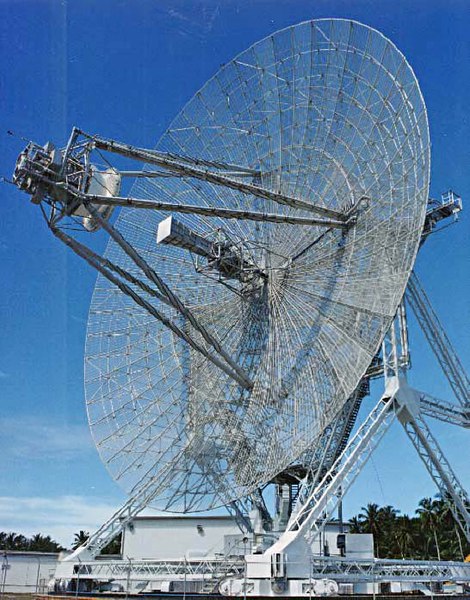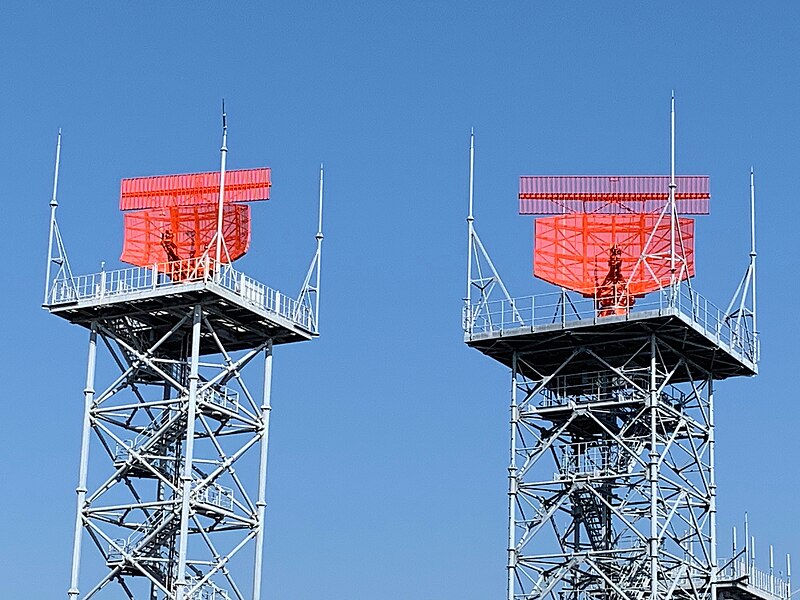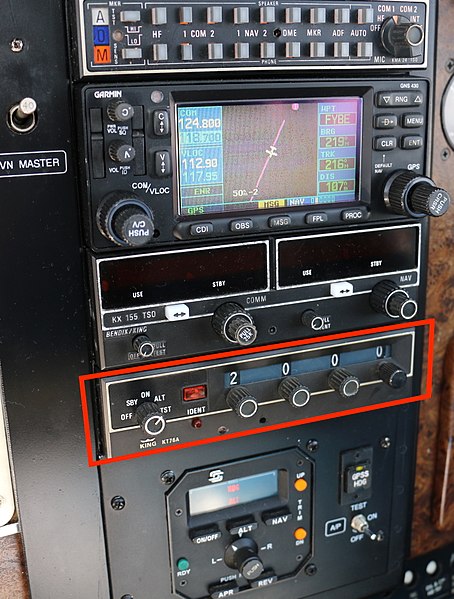Radar, an acronym for Radio Detection and Ranging, is one of the most important technologies for tracking aircraft and keeping our sky safe. Radar operates by transmitting radio waves and analyzing the radio waves reflected from objects. A radar system consists of a transmitter, antenna, receiver, and signal processor. The transmitter generates high-frequency radio waves, which the antenna directs into space as a focused beam. When these waves encounter an object, such as an aircraft, a portion of the energy is reflected back to the radar’s receiver. By measuring the time delay between transmission and reception, the system calculates the target’s range, while the antenna’s orientation determines its direction and elevation.

Photo: US Army | Wikimedia Commons
Doppler Effect: The physics behind how radar detects aircraft
We’ve all heard that sound produced by an automobile (such as a car) that is headed toward us has a different kind of noise profile compared to when the automobile is headed away from us. The physics behind how this happens was documented by the Austrian mathematician and physicist Christian Doppler (1803-1853). The effect is measured in terms of the frequency of the signal (in the case described above, it was the automobile’s noise profile), reported NASA:
” The Doppler effect is routinely measured in the frequency of the signals received by ground receiving stations when tracking spacecraft. The increasing or decreasing distances between the spacecraft and the ground station may be caused by a combination of the spacecraft’s trajectory, its orbit around a planet, Earth’s revolution about the Sun, and Earth’s daily rotation on its axis. A spacecraft approaching Earth will add a positive frequency bias to the received signal. However, if it flies by Earth, the received Doppler bias will become zero as it passes Earth, and then become negative as the spacecraft moves away from Earth.”

Waves tend to stretch up when a source is moving away from the observer while the waves tend to pile up when moving towards an observer. A source moving away is said to be “red-shifted” while the source moving towards an observer is said to be “blue-shifted”.
RADAR makes use of electromagnetic radiation’s interference with system operations to detect an aircraft. Research suggests that there are various techniques aimed at locating an aircraft using a RADAR:
“Some of them focus on a particular type of aircraft such as propeller-driven and helicopters taking advantage of their emitted narrow-band noise with dominant tonal components…. The Acoustical Doppler Effect is the basis of the methods for propeller-driven aircraft tracking… They use a single microphone located on the ground below the flight path and rely on the temporal evolution of the frequency spectrum. The evolution of the Doppler shift permits an estimate of the altitude and speed of the sound source..”
Radar Types: How and where they are used for aircraft tracking
Active radars
Active radars emit their own radio waves for target detection. When the waves bounce off the target, the radar measures the distance, velocity, and location of the target. They are very adaptable and reliable so are used for precise and reliable radar control to detect a wide range of stationary and moving targets. They are generally used in:
- Air Traffic Control
- Weather Monitoring
- Military bases
- Ship navigation
Passive radars
Passive radars depend on existing signals from other sources in the environments like FM radio stations, television broadcast and mobile phone signals. The reflected signals from the target are detected by the passive radars and track and identify the targets. They have limited range and resolution, and they are unreliable as they depend on external environments. They are mostly used in surveillance and military application where stealth is critical.

Photo: Graeme.nayler | Wikimedia Commons
Multistatic radars
Multistatic radars use multiple radar stations as transmitters and receivers located at different positions. Multistatic radars can analyze the target’s reflections from different angles and distances allowing accurate detection. Since it utilizes multiple receivers it is resilient to radar blocking [it was the case that the Caspian Sea Monster wasn’t visible to a lot of radar]. Multistatic radars are primarily used in military and air traffic control for surveillance.
Radar in air traffic control
There are generally two types of radar in the context of air traffic control (ATC).
1. Primary surveillance radar (PSR)
Primary surveillance radar (PSR) detects aircraft by sending out radio waves and measuring the time it takes for them to bounce back after hitting the aircraft. PSR doesn’t rely on any onboard equipment in the aircraft. Here are a few capabilities of the PSR:
- Helps air traffic controllers detect and track aircraft in the airspace
- Works with all aircraft, including those without transponders
One has to note that PSRs are generally associated with limited accuracy and resolution and are incapable of providing information about the aircraft’s identity, altitude, or velocity.

Photo: Project Kei | Wikimedia Commons
2. Secondary surveillance radar (SSR)
Secondary surveillance radar operates by receiving signals from the aircraft’s transponder. The aircraft sends out a response when it receives an interrogation signal from the radar allowing radar to determine aircrafts information’s like identity, altitude, velocity and position. It provides more detailed information compared to PSR and is often used in controlled airspace for precise tracking. Relies on aircraft having a working transponder, so it doesn’t work with all aircraft (especially older ones).
3. Combination of PSR and SSR
Some radar systems combine both primary and secondary radar capabilities, offering the benefits of both systems. This allows controllers to receive both positional data and aircraft identification data. These are primarily used in areas where both types of radar are necessary to ensure safe and effective surveillance.
The effectiveness of radar detection hugely depends on the radar cross-section of the target, which quantifies its ability to reflect electromagnetic energy. Larger values with conductive materials like commercial aircraft have higher regular cross-section (RCS) value, while stealth aircraft or drones have smaller RCS value, making them hard to detect. Modern radar systems also use the Doppler effect to distinguish moving and stationary objects by the shifts in the frequency of reflected waves from the target.
Aircraft identification and tracking
The role of surveillance radar is to provide continuous monitoring of aircraft within a certain airspace. Primary surveillance radar detects targets by analyzing the reflected radio waves in noncooperative means without relying on onboard transponders. They are essential for monitoring non-responsive and unauthorized aircraft.
SSR in contrast interacts with transponders of aircraft to obtain detailed information such as altitude, identity, and velocity. This works by transmitting interrogation signals, which trigger transponder replies that encode data in standardized formats eg: (mode A/C/S). This cooperative surveillance method enhances security and safety in congested airspace where rapid identification is critical.
Integration of PSR and SSR enables comprehensive airspace management which are essential for international civil aviation organization standards. For example: ‘Shoghi Communications’ SCL-MSSR system combines both technologies to track up to 500 aircraft simultaneously. These systems employ advanced clutter attenuation algorithms to filter out interference from weather, birds, or ground structures, ensuring reliable target detection.
Transponders and Enhanced Aircraft Identification
Transponders are critical components in modern aviation, serving as the bridge between aircraft and Air traffic control(ATC) radar systems. It is used for aircraft detection and identification.

Photo: Hp.Baumeler | Wikimedia Commons
When SSR sends interrogation signals, the transponder emits a coded response that contains an aircraft’s unique identifier such as:
- Altitude
- Speed
- Course
and other parameters. This process maintains accurate aircraft tracking whilst also enhancing safety by providing controllers with real-time updates.
Signal Processing and Analysis
Raw radar data contains noise, clutter, and interference, hence necessitating sophisticated signal processing. Sophisticated signal processing technique is crucial for achieving high-resolution processing and highly precise object detection.
Some of the processing techniques used in radar are:-
| Processing technique | Method of detection |
| Pulse doppler processing | Detects moving targets by filtering out stationary echoes using the Doppler shift phenomena. |
| Clutter suppression algorithms | Differentiates aircraft from weather phenomena or ground objects |
| Synthetic Aperture Algorithms | It helps to generate high-resolution images of terrain and objects. |
| Moving Target Indication | It helps differentiate moving aircraft from stationary objects by analyzing phase shifts in radar returns. |
| Fast Fourier transform analysis | It converts radar signals into frequency components improving signal clarity and target identification. |
| Adaptive Thresholding | It dynamically adjusts radar sensitivity to reduce false alarms and improve detection accuracy. |
Challenges in Aircraft Detection
The development of stealth aircraft and small UAVs has intensified challenges in radar detection. Some of the factors that make aircraft hard to detect are :
1. Low radar cross section (RCS): Stealth aircraft like the F-22 Raptor and b-2 Spirit have an RCS smaller than a bird, making them difficult to track.
2. Radar Absorbent Materials: It is a special coating that absorbs radar waves which prevents reflection back to the radar..
3. Angular Design & Edge Alignment: Stealth aircraft are designed in a way that deflects the radar signals away from the radar.
4. Electronic Warfare (EW) & Jamming: Some aircraft jam radar signals making them invisible to the radar.
5. Low-Altitude Flight & Terrain Masking: UAVs and fighter jets use hilly terrain to hide from radar by flying low.
Specialized Radar Technologies for aircraft detection
Frequency-Modulated Continuous-Wave (FMCW) and Continuous-Wave (CW) Radar
Continuous wave radars emit continuous signals where a Doppler effect helps to find the velocity of aircraft but doesn’t give information on the aircraft’s location. In contrast, frequency-modulated continuous wave emits a modulated continuous wave where a radar compares the frequency of the signal it sends out with the frequency of the signal it receives back from an object.
The main advantage of CW radar is that they are great for detecting fast-moving objects like cars but not for telling their exact distance. On the other hand, the advantage of FMCW is that it can measure both speed (like CW radar) and distance. FMCW are really useful for things like detecting small objects like drones or things that are far away or moving slowly.
Advanced Radar Technologies for UAV Detection: Adapting Radar for Small Drone Surveillance
Drones are difficult to detect because they are small, fly low and move slowly which makes their radar cross-section very small and difficult to detect. Traditional radar can struggle with these and can mistook the drones from other objects such as plants, birds and debris.
Because FMCW radars can measure both range and velocity, they are great for detecting drones. Additionally using micro-doppler analysis, the radar can detect specific patterns in the reflected radar signals that come from things like rotating drones blades which can help distinguish drones from other objects like birds and debris. Furthermore an effective and efficient UAV classification system based on FMCW surveillance radar echo signals can be made.
Next-Generation Radar Innovations
Cognitive and MIMO Radar Systems
Cognitive Radar is an intelligent system that is aware of its surrounding environment (i.e., outside world), uses prior knowledge as well as learning through continuing interactions with the environment, and thereby adapts both its receiver and transmitter in response to statistical variations in the environment in real-time so as to meet specific remote-sensing objectives in an efficient, reliable, and robust manner. These radars are good at detecting objects in dynamic situations like when an object is trying to hide from the radar.
A MIMO radar system is an advanced radar system that uses multiple antennas to send and receive signals at the same time that means they have multiple transmitters and receivers working together which creates a clear and detailed picture and environment. They improve the radar’s resolution and reduce interference. This helps the radar to track objects effectively even in complex environments.
Conclusion
The basic scientific mechanism of how an aviation radar detects an aircraft is rather simple: a radar sends out a signal and based on how signals are distorted, the possibility of an aircraft’s presence is noted. However, underlying equipment that allow for detection is quite sophisticated. And what’s more, the technology is forever evolving, necessitating the use of the state of the art science in a world of rapidly evolving aviation technologies.
